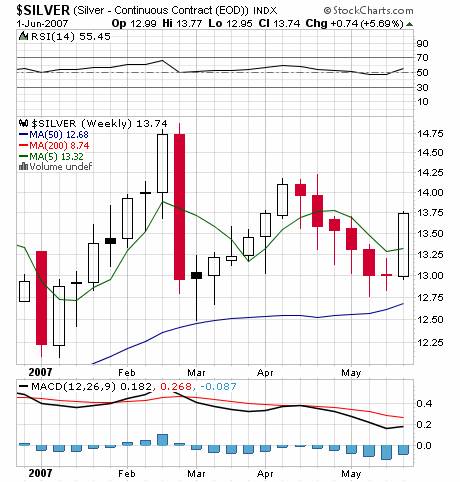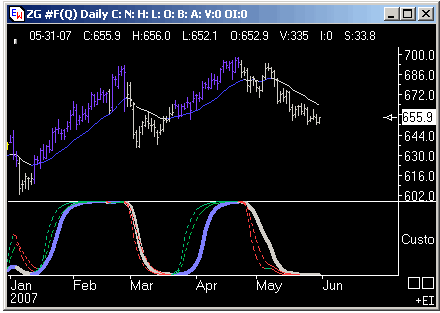Gold and Silver Analysis - Precious Points: Why This Rebound Looks Real
Commodities / Gold & Silver Jun 03, 2007 - 04:43 PM GMTBy: Dominick
Joe Nicholson writes : “With the market all but giving up on rate cut relief this week, the proliferation of leveraged buyouts and junk bond issuance, and the steady surge in bank loans and global liquidity, give every indication that real interest rates might be too low.” ~ Precious Points: No Lack of Support , May 27, 2007
Weeks ago this update said that what gold needs to get back its shine is a rebound in the U.S. economy. As you know, this is exactly what recent data has suggested, and the metals have acted accordingly. The focus for some time here has been on the Fed's open market activity, and specifically the “sloshing” repo funds. After breaking the streak of reverses two weeks ago with a modest $3 billion net addition, last week concluded with a net add of $6.75 billion. In a rate-targeting regime, this reflects perception of a stronger economy driving demand for more base money, and the overall liquidity is an ideal environment for appreciation of precious metal.
It's not surprising then, that the metals put on a bit of a rally last week. Caution at this point is reasonable, considering that other strong closes over the past month have quickly reversed and frustrated dip buyers. Last week's update required a weekly close above the 5-day moving average to begin confirmation of a new bullish move in precious metals. Notice in the charts below how, particularly in silver, rallies off the weekly lows that nonetheless closed under the 5-day moving average ultimately became extensions of a downtrend, whereas successive closes above the 5-day moving average marked recovery and further rallies from the severe selloffs in early January and late February.


Now that both gold and silver have climbed above, the 5-day moving average becomes an important support level which, though not inviolable, signals a relatively low risk/reward trade. Even if the 5-day average is lost during the week, closing on Friday above the 5-day moving average would suggest a larger move, probably to a new interim high, though strong resistance exists in gold at the $690-700 level, and at the $13.95-$14.15 level in silver. Note that previous moves above the 5-day moving average this year, though triggering rallies, have not escaped punctuation by sharp declines. But even here, it's losing the 5-day average in a single week from a fresh high that marks the crucial turn and ultimate retreat back into the 50-day level.
Last week did not see the short term top in bond yields anticipated in the previous update, despite less than 1% GDP growth for the second quarter. As prices sunk even lower, talk centered on the 10-year Treasury and the yield it would ultimately take to tempt investors from stocks to fixed income.
But, just as new highs in the metals are not a foregone conclusion, neither is a Fed rate hike or a sustainable resurgence of the U.S. economy. Strength in job creation, in manufacturing, and in construction all suggest Q2 will be the low mark of this slowdown, and that GDP will be higher in the second half of the year, just as Fed members have expected. Proponents of this outlook essentially believe any loss of wealth effect due to a decline in housing prices has been more than offset by the stock rally and that, unless consumer discretionary spending drops off a cliff, inventories will be consumed and the economy will begin to accelerate from here.
There are flaws to this argument, though. Jobs numbers are widely believed to be exaggeratedly high and, anyway, do not account for undocumented workers, who nonetheless do figure into retail spending. And, though many Americans own stocks indirectly through their retirement or pension accounts, this is not discretionary income that they'll spend at Walmart, though perhaps at the new Macy's. But, despite high confidence numbers, the willingness of consumers to liquidate or borrow against stock holdings as a way to fund new purchases is yet to be proven.
The rate hike camp also assumes that, simply because subprime mortgage defaults have not yet spilled over into the rest of the economy so far, they never will. By Bernanke's own admission, the number and value of defaults are going to increase through 2007 and 2008. Even if the Fed doesn't hike rates, even an incremental rise in bond yields, and the resultant increase in all manner of credit spreads including home and auto mortgages and credit cards, will translate into even larger payments for owners of ARMs, and most likely into a larger number of defaults. The last two Fed statements left the back door open to a rate cut, and this could still materialize if housing defaults increase dramatically and consumer spending deteriorates, since, rather than the virtuous cycle of spending and production anticipated by the rate hikers, this scenario envisions a vicious cycle of deflationary write-downs and tightening household budgets that would see short term weakness in metals, but longer term strength.
The tension between opposing forces which have kept the Fed steady, has thus far created a relatively stable bond market. And, yields that gradually creep higher typically signal a bullish environment for metals. Now, if the impetus to cut rates is in fact removed, bond yields could be expected to reach a more historically normal level, above the overnight rate at 5.25%. As suggested last week, a fixed return of 5.25, even 5.5, over ten years, seems grossly inadequate next to a 6.6% annual increase in M2 and vastly higher returns in foreign and domestic equity. The real risk seems to holders of corporate bonds who face increased exposure to rising yields and widening spreads, though markets are not always entirely rational and occasionally succumb to self-fulfilling prophecy.
So, it's not the nominal rate, at least not at anywhere near these levels, as much as the rate of increase that would determine the effect on stocks and metals. A sudden lurch to higher yields could trigger a liquidity freeze and a sharp correction in stocks and metals, whereas a more gradual rate of climb should be easily absorbed by the markets. Still, this seems unlikely as next week is relatively light on economic data, and bond traders will probably remain patient ahead of further signs of life from the consumer – which puts the weekly chain-store sales figure in particular focus. Obviously, an exodus from stocks to bonds would put acute pressure on metals and mining stocks, but would probably not violate the support outlined last week and, in moderating the climb in yields, could actually strengthen the intermediate picture.

TTC's proprietary trend cycle chart has been doing a great job as shown in the above chart. We have now added Daily and Weekly trend charts to 24 markets!
These charts, as well as the intraday trend page at TTC, are available to members only. The monthly subscription fee will be increasing on or about July 4th due to our ongoing expansion of the Website, computer and software upgrades, and the addition of services such as trend cycle charts. Current members and anyone that joins before the increase takes effect will not be subject to the new price, and will continue paying the current $50 subscription fee on a month-to-month basis. So, if you have been thinking of joining, this is a great time, while it's still less than just 5 oz silver or 1/10 oz gold!
by Joe Nicholson (oroborean)
This update is provided as general information and is not an investment recommendation. TTC accepts no liability whatsoever for any losses resulting from action taken based on the contents of its charts,, commentaries, or price data. Securities and commodities markets involve inherent risk and not all positions are suitable for each individual. Check with your licensed financial advisor or broker prior to taking any action.
© 2005-2022 http://www.MarketOracle.co.uk - The Market Oracle is a FREE Daily Financial Markets Analysis & Forecasting online publication.



